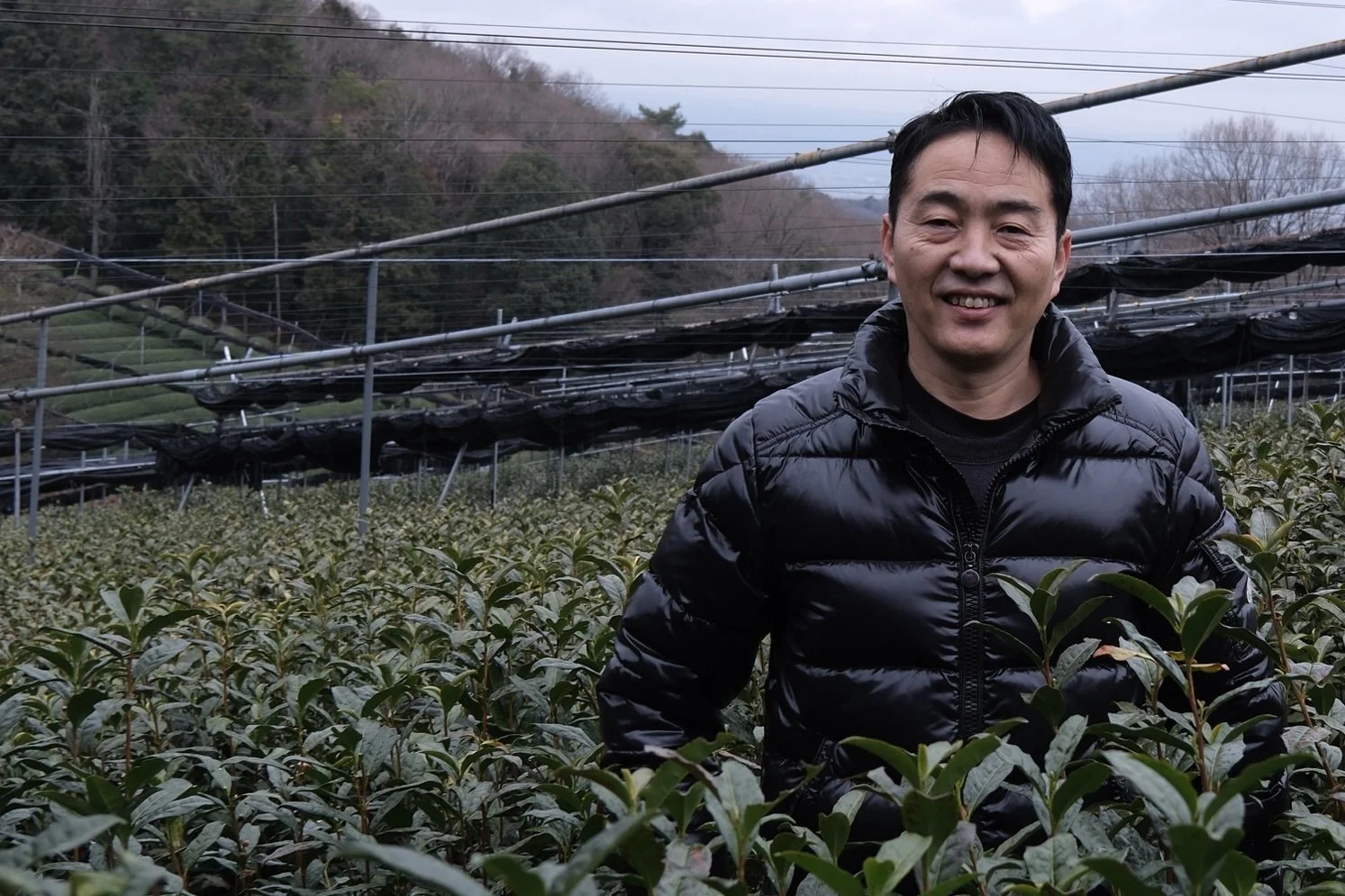Matcha - HARUKA BY TSUJI KIYOHARU
Buy this tea here
Matcha in kanji means ground tea, but doesn’t specify exactly which tea leaves are used - the large majority of high grade matcha is ground from tencha, though occasionally gyokuro (the king of Japanese teas) may be used. Tencha and gyokuro are grown in relatively the same way; covered from the sun and grown in varying amounts of shade for the last 16-30 days prior to harvest. This covering blocks direct sunlight and interrupts photosynthesis, stressing the plant and changing the flavour of the tea as the amino acids inside the tea leaves are prevented from changing into catechins, resulting in a higher level of amino acids (which give umami flavour and sweetness) in shaded tea compared to unshaded tea. The difference between tencha and gyokuro is after being steamed and dried there is no need for tencha to be rolled as it is usually ground into matcha, whereas gyokuro leaves are rolled into thin needle shapes. It has been speculated that lower grade matcha that is more yellow in colour or particularly bitter could have been ground from later harvest tea, or sencha or bancha tea leaves which are not grown under any shade at all. Second and later harvest tea have much lower levels of amino acids, and much higher levels of catechins (astringency and some bitterness). Quality matcha should always be stone ground from first harvest tea.
In Japan there are three main categories of matcha; matcha which can be made as usucha or koicha, matcha which is for making usucha but not suitable for koicha, and culinary grade matcha. This Haruka is an incredibly versatile blend of tencha cultivars from Shirakawa, Uji, Kyoto, by fifth generation tea farmer and living legend Tsuji san. It is stone ground in the traditional way (a must for quality matcha) rather than the quicker machine grinding which damages the taste due to increased friction heat. Stone grinding typically yields only 30-40g of matcha per hour, and is done in rooms kept at low temperatures to minimise oxidation.
We love that Haruka can be prepared as usucha, as a matcha americano, or as a matcha latte, and taste amazing in each! You will notice more complexity in the flavour profile when prepared just with water, but it can stand against milk too. In fact, we also enjoy this matcha in a very slightly sweetened matcha latte! Such versatility is extremely hard to come by, and we are so proud to be able to work direclty with Tsuji san to bring his hard work all the way to the UK and beyond!
Hot or Iced matcha latte:
Matcha: 5g
Water: 65ml @ ~70°C
Milk or milk alternative: 165ml hot or iced
Sift the matcha into a bowl and pour in the hot water, then preheat your chasen and whisk quickly but gently - taking care not to damage the chasen by using too much force. Smooth glazed bowls are best for this! Combine with hot or iced milk - for Haruka matcha we prefer dairy or oat. Rinse chasen asap.
Iced matcha:
Matcha: 2g
Water: 60-80ml @ ~70°C
Sift matcha into a bowl and pour hot water over, then preheat chasen in hot water for 10 seconds and whisk rapidly, slowing down towards the end to remove bigger bubbles. Pour over lots of ice. Rinse chasen asap.
Storage:
Store in a cold environment (6-10°C) and avoid exposure to light, air, heat, moisture and strong smells - these will degrade your tea. Once opened, best consumed within 1 month for the best experience. Squeeze out excess air from bag before sealing.
About Matcha Freshness:
Mokuren’s tea producer suggests to enjoy quality matcha within 7 months from being stone ground. Other quality tea producers suggest 6 months, some suggest 8 months. In our opinion, any use by date longer than 9 months is a sign that the seller doesn’t care much about freshness of matcha - a non oxidised tea with particle sizes of 6-8 microns. As we push towards increasing the transparency from the origin of the tea all the way to the final consumer, we are adding the stone grind date to all matcha purchased from us along with a suggested use by date (unopened). We challenge everyone looking to buy matcha to enquire about the grind date for the matcha you are buying, and we challenge all matcha sellers to provide this date as it is the only date that matters concerning the freshness of the tea before it is opened.
Once opened, high quality matcha’s freshness is best enjoyed within 4 weeks. Again, some tea producers suggest less, and others are more lenient. We want the final consumer of the tea to have the essential information (stone grind date and open date) to be able to keep track of when the matcha was ground and when it was opened, to decide for themselves how strict/lenient to be. To encourage this, there will also be a small space on the matcha pack/can for you to write the date you open the matcha. We want you to see if you notice the flavour change over time, and come to your own conclusions about how important freshness is!
We know that while the tea is safe to consume for much longer than 6-8 months after grinding, it is a target to set that allows the bright vivid flavours to still be enjoyed. The longer the matcha sits unopened the more dull the flavours will become. Fridge storage will help to delay the flavour degradation, and for room temperature storage we would recommend to use within 3-6 months. We don’t have much experience with freezing matcha but if you would like to, it is a good idea to refrigerate for one day before freezing and again after removing from the freezer (and then place in room temperature for a few hours before opening) to slow the temperature changes.

